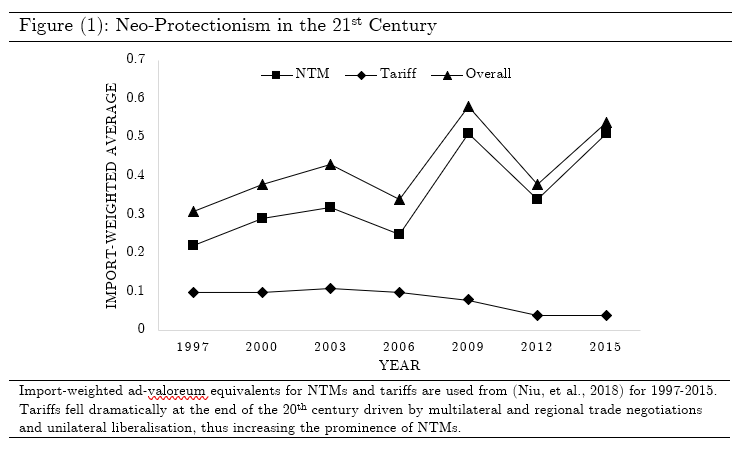(Question asked by the Marshall Society)
This society takes the view that traditional tariff protection, overall, is bad for societal welfare; but given the growing prevalence of non-tariff measures, the welfare effects of neo-protectionism are a lot more ambiguous.
The opening up of markets across the globe in the last century has been characterised by a reduction in tariffs, pushing non-tariff measures (NTMs) to the forefront of modern trade negotiations. NTMs can be welfare enhancing even if they restrict trade, as they are used to address types of policy objectives such as environmental impact, public health and consumer safety. The conflicting objectives provides opportunity for firms to affect NTM adoption through lobbying, and drives the potential for distortion of these measures for firm or industry level protection.
In recent years, quantity and price controls and other NTMs have increased in number, as shown in Figure (1). The proliferation of sanitary and phytosanitary measures and technical barriers to trade are less explored, but comprise up to 90% of NTMs (Nicita & Gourdon, 2013). The ability to comply with complex regulatory regimes drives trade flows and market access (Basu, 2011).

Technical and complex policy decisions obscure the policy making process, with the lack of transparency or oversight from voters hiding protectionism (World Trade Organisation, 2012). NTMs should be a more efficient form of protectionism for both businesses and politicians, since lobbying contributions must compensate the government for deadweight loss (Grossman & Helpman, 1994). Democracy impacts the policy making process, causing lower tariffs and higher NTM adoption to protect markets under the guise of liberalisation (Kono, 2006). This result follows from the political agency model developed by Sturm (2006).
Studies into the trade effects of ‘legitimate’ NTMs find over half of those implemented in Asia & Pacific region directly address UN Social Development Goals (Economic and Social Commission for Asia and Pacific, 2019). These measures raise the cost of imports in the region by 15%, showing the trade effects even the most innocently implemented NTM faces. This creates economically significant windfalls in trade policies reducing them (Hoekman & Nicita, 2011).
The takeaway from all this is that whether a measure is ‘protectionist’ matters less than the trade-off between the main welfare benefit of the measure and the welfare loss of the protection. Inclusive incentive structures should be developed, such as the EU Commission’s approach of incorporating industry forums and experts into policymaking processes, thus meaning firms must take a long-term approach to protection lobbying. NTMs will continue to dominate trade issues as policymakers enjoy the extension of sovereignty they offer into other markets and the political objectives they address. Increasingly comprehensive trade agreements will seek to break down barriers to intellectual property, bilateral/multilateral investment and procurement (all NTMs). This society believes, given the high weighting of social welfare in a policymaker’s decision function, highlighted by Goldberg & Maggi (1998), non-tariff measures are something to encourage if they do not impede an individual’s liberty.
References:
Basu, B. K. A. L. S., 2011. Evolution of Non-Tariff Measures: Emerging Cases from Selected Developing Countries. Policy Issues in International Trade and Commodities., 1–27: UNCTAD Study Series.
Economic and Social Commission for Asia and Pacific, 2019. Asia Pacific Trade and Investment Report: Navigating Non-tariff measures towards Sustainable Development, s.l.: United Nations.
Goldberg, K. & Maggi, G., 1998. Protection for Sale: An Empirical Investigation. The American Economic Review, 89(5), pp.1135–1155.
Grossman, G. & Helpman, E., 1994. Protection for Sale. The American Economic Review, pp.833–850.
Hoekman, B. & Nicita, A., 2011. Trade policy, trade costs, and developing country trade. World Development, pp.2069–2079.
Kono, D. Y., 2006. Optimal Obfuscation: Democracy and Trade Policy Transparency. The American Political Science Review, pp.369–384.
Nicita, A. & Gourdon, J., 2013. A Preliminary Analysis on Newly Collected Data on Non-Tariff Measures. Policy Issues in International Trade and Commodities., 1–32: UNCTAD Study Series.
Niu, Z., Liu, C., Gunessee, S. & Milner, C., 2018. Non-tariff and overall protection: evidence across countries and over time. Rev World Econ, Volume 154, pp.675–703.
Sturm, D., 2006 . Product standards, trade disputes, and protectionism. Canadian Journal of Economics/Revue canadienne d’économique, pp.564–581.
World Trade Organisation, 2012. World Trade Report 2012, Trade and public policies: A closer look at non-tariff measures in the 21st century, Geneva: World Trade Organization.



0 Comments